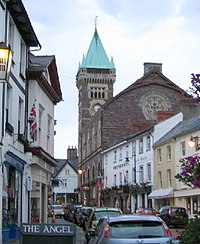Abergavenny
Abergavenny
|
|
|---|---|
 Abergavenny town centre, showing the Market Hall and town hall clock tower |
|
| Abergavenny shown within Monmouthshire | |
| Population | 10,078 (2011) |
| OS grid reference | SO295145 |
| Community |
|
| Principal area | |
| Ceremonial county | |
| Country | Wales |
| Sovereign state | United Kingdom |
| Post town | ABERGAVENNY |
| Postcode district | NP7 |
| Dialling code | 01873 |
| Police | Gwent |
| Fire | South Wales |
| Ambulance | Welsh |
| EU Parliament | Wales |
| UK Parliament | |
| Welsh Assembly | |
Abergavenny (/ˌæbərɡəˈvɛni/; Welsh: Y Fenni pronounced [ə ˈvɛnɪ], archaically Abergafenni meaning "Mouth of the River Gavenny") is a market town in Monmouthshire, Wales. It is located 15 miles (24 km) west of Monmouth on the A40 and A465 roads, 6 miles (10 km) from the English border. Originally the site of a Roman fort, Gobannium, it became a medieval walled town within the Welsh marches. The town contains the remains of a medieval stone castle built soon after the Norman conquest of Wales. The town hosted the 2016 National Eisteddfod of Wales.
Abergavenny is promoted as a "Gateway to Wales". Situated at the confluence of a tributary stream, the Gavenny, and the River Usk, it is almost surrounded by two mountains – the Blorenge (559 m, 1,834 ft) and the Sugar Loaf (596 m, 1,955 ft) – and five hills: Ysgyryd Fawr (The Skirrid), Ysgyryd Fach (Skirrid Fach), Deri, Rholben and Mynydd Llanwenarth, known locally as "Llanwenarth Breast". It provides access to the nearby Black Mountains and the Brecon Beacons National Park. The Offa's Dyke Path is close by and the Marches Way, the Beacons Way and Usk Valley Walk all pass through the town.
...
Wikipedia

